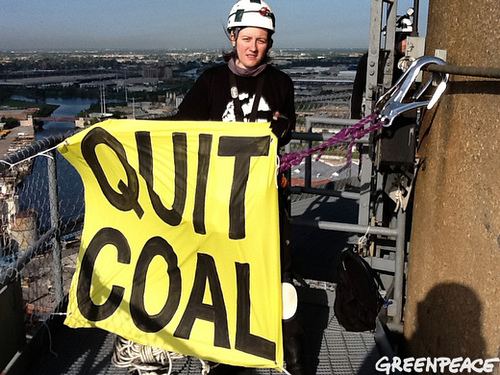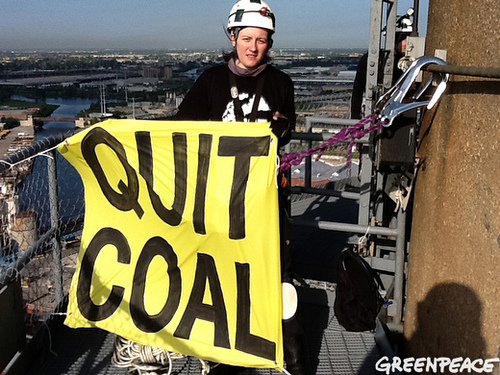 Greenpeace activists climbed the smokestack at the Fisk coal plant.Photo: GreenpeaceA sad fact of living in an American city like Chicago is that every time we open a newspaper or switch on the local news, we hear of some senseless, tragic crime that has claimed an innocent life.
Greenpeace activists climbed the smokestack at the Fisk coal plant.Photo: GreenpeaceA sad fact of living in an American city like Chicago is that every time we open a newspaper or switch on the local news, we hear of some senseless, tragic crime that has claimed an innocent life.
We become outraged, and we demand justice for those who have lost their children, their parents, their siblings or spouses. In 1982, Chicago acted to stem the tide of gun-related violence when confronted with a disturbing rise in homicides. In fact, between 1980 and 2006, some 32,300 Americans died every year due to handgun violence, which is second only to car crashes in deaths by injury.
Ever since I got my start as an advocate for a healthy environment on Chicago’s West Side, I have wondered why we fail to feel that same sense of outrage when the culprit in a crime against innocents is not a gunman seeking cash, but a corporation seeking to improve its bottom line. Maybe the impacts of a company’s misdeeds are of a scale so grand that it is difficult for us to imagine.
Every year, the toxic pollution that spews from the smokestacks of America’s coal-fired power plants kills between 13,000 and 34,000 people, according to studies by the Clean Air Task Force [PDF] and Harvard University. That staggering figure doesn’t include the carbon pollution — one third of all U.S. emissions — that is driving the planet into runaway climate change.
The lives lost to the coal industry are as real and as important as any other, as are the dollars the industry plucks from our pockets without us ever knowing it. Between health-care costs for heart attacks, asthma attacks, and other respiratory diseases; birth defects; and damage to communities done by mountaintop-removal mining, land degradation, solid coal wastes, and other impacts; the hidden costs of coal amount to half a trillion dollars annually, according to a recent study by Harvard Medical School’s Center for Health and the Global Environment.
That’s $500 billion that you and I are paying to the coal industry so that they can continue poisoning our communities and standing in the way of clean, green energy. This massive, invisible public cost is only one of the many accounting tricks used by utilities to rob the public of billions each year.
If that scale is too hard to imagine, perhaps we should focus on a more local level. The city of Chicago is home to two ancient coal-fired power plants, owned by Edison International subsidiary Midwest Generation. The Fisk Street and Crawford plants spew millions of tons of pollutants — including nitrogen oxides, sulfur dioxides, and barium — that cause health impacts like those mentioned above. They churn out more carbon pollution than any other single source in Chicago.
And, according to multiple studies, these two facilities kill more than 40 people of this city every year. If those numbers bother you, they should. But even more scandalous is this figure: the number of Chicago homes and businesses that they power is exactly zero. Fisk and Crawford were originally built in 1903 and 1924 to provide power to the city, but since California-based Edison International bought them in 1999 they have not been needed in Chicago and have instead sold their power to the open markets in the mid-Atlantic.
So these plants are sickening and killing Chicagoans to send power to the East Coast and profits to California. Adding insult to injury, while Edison is claiming that coal is the only way to preserve jobs in Illinois, they are investing millions of dollars in job-creating clean, green energy in southern California. Instead of southern California’s skyrocketing clean energy industry, Chicago is saddled with $127 million in health costs as a result of these two old coal plants.
This situation persists because of a failure of our government to have the courage to protect people. Lobbyists have gutted commonsense public health safeguards, with predictably disastrous results for regular people. One example is the EPA’s decades-long failure to rein in the pollution pouring from the smokestacks of coal-fired power plants — a situation they’re finally looking to correct. Sadly, the failure also extends to Chicago’s city government, which last month failed to vote on Alderman Joe Moore’s Clean Power Ordinance, which would have reined in the pollution from Fisk and Crawford.
But sometimes overlooked is the fact that companies like Edison bear real responsibility to the communities that surround them. Fisk and Crawford are a good example. In pursuit of profit, Edison continues to run power plants whose electricity is no longer needed by Chicagoans while people get sick and die.
Chicago’s clean power coalition, made up of over 50 local groups, have continually shown Edison that people can stand up to the enormous and destructive power of the coal industry. The people who have written letters, showed up at hearings, marched, rallied, and called their aldermen are my inspiration and our great hope for the future. Today, Greenpeace activists scaled the smokestack of the Fisk Street station to support them and make sure the message is heard all the way back in California.




